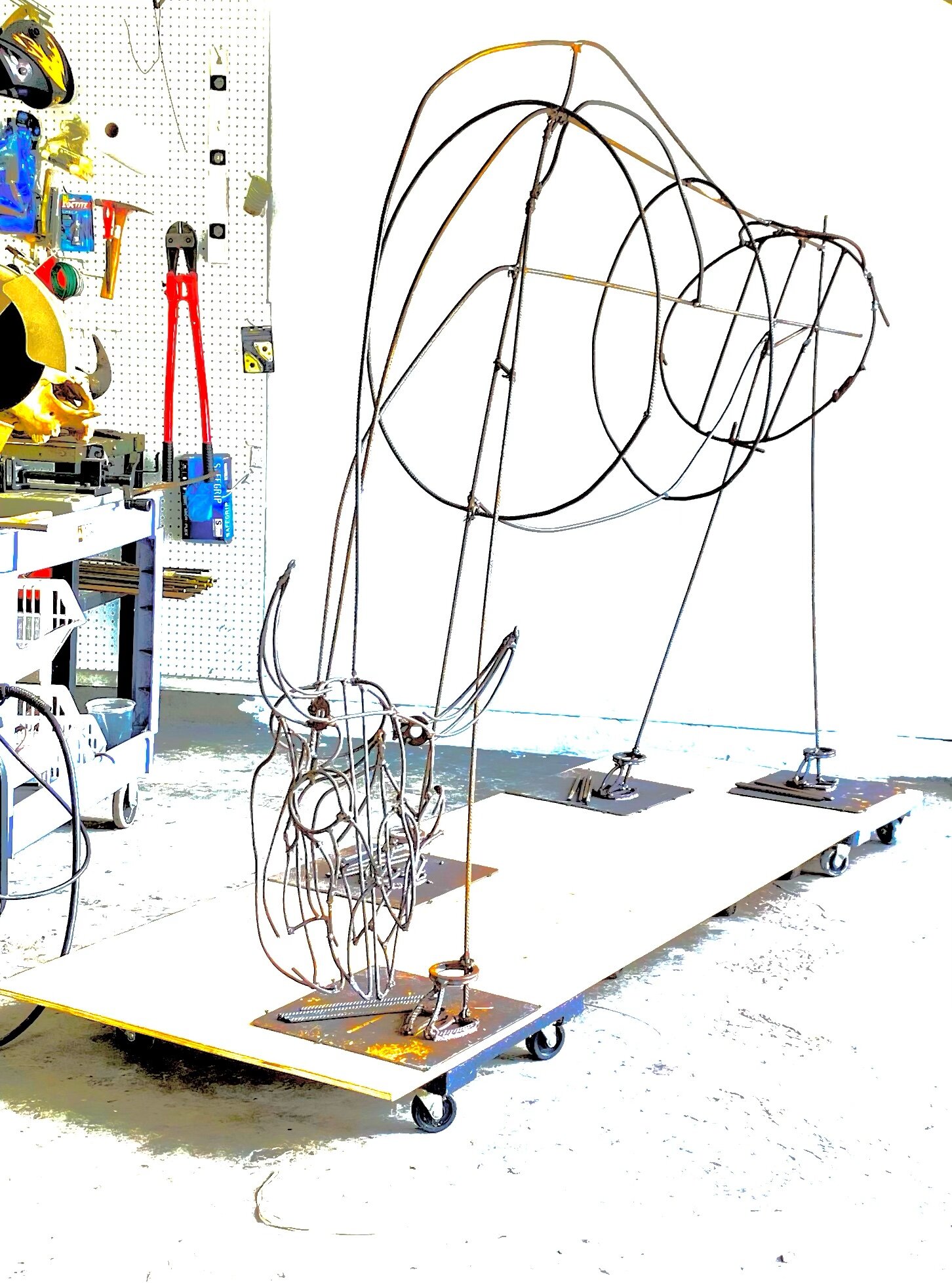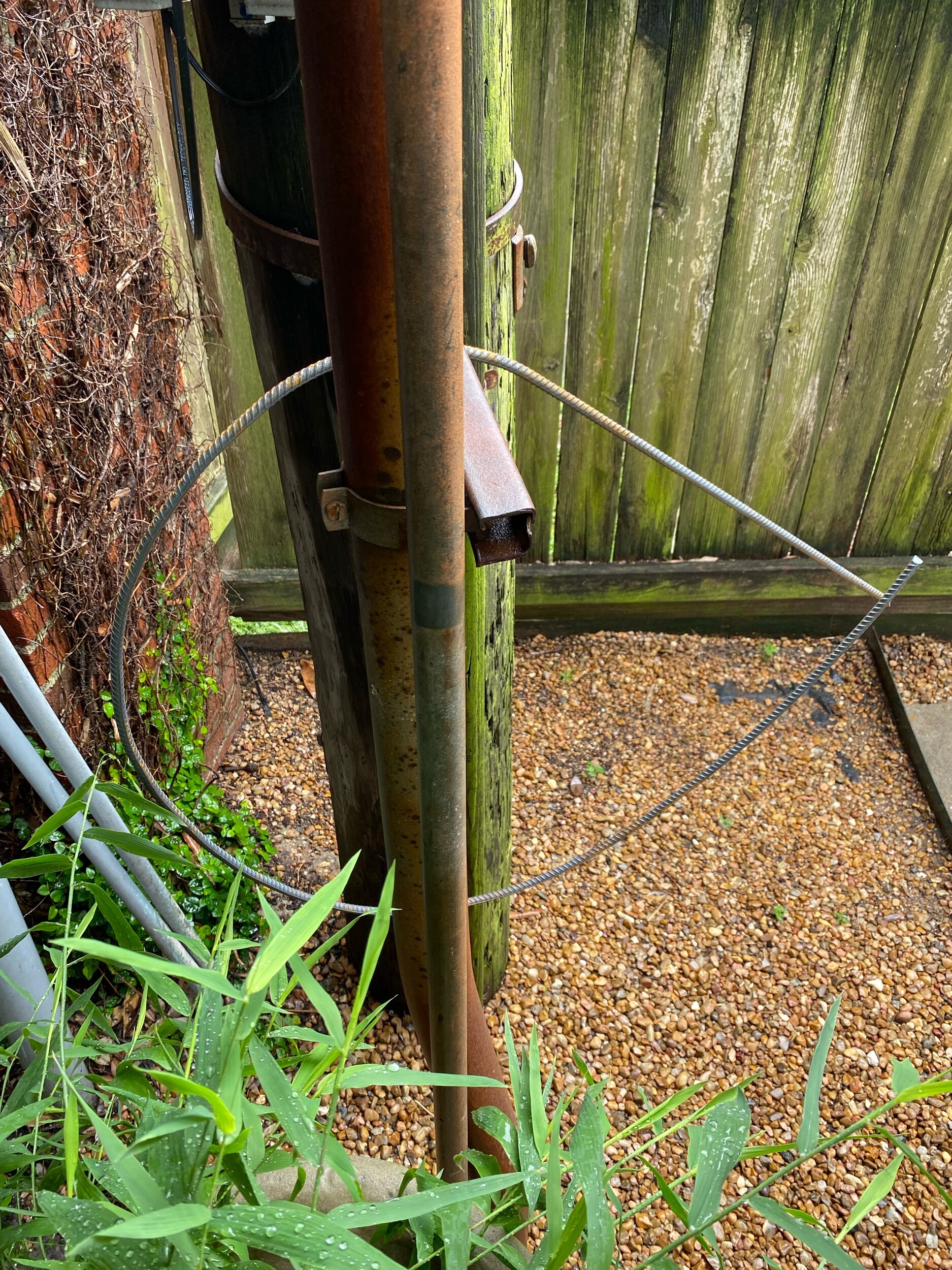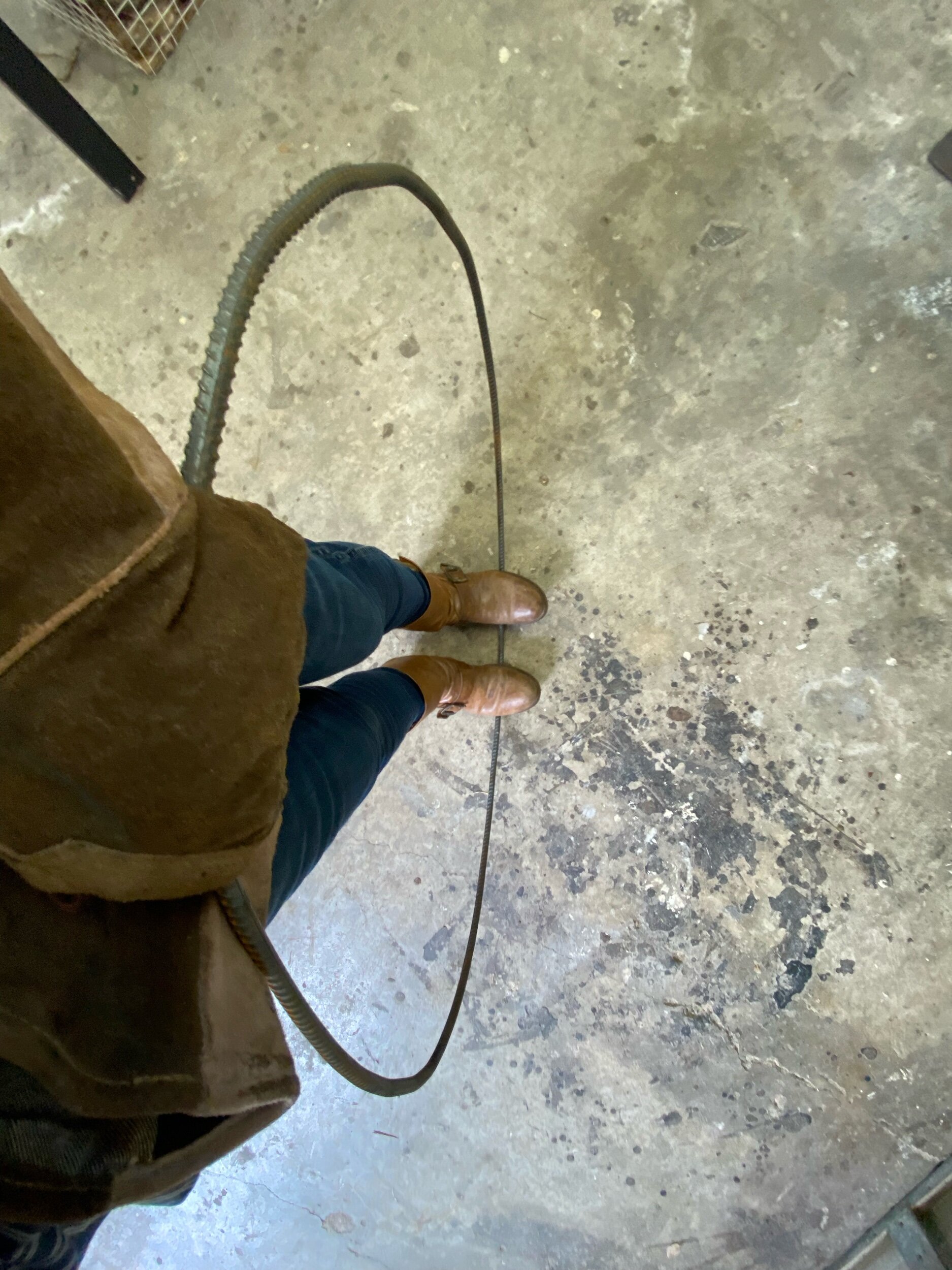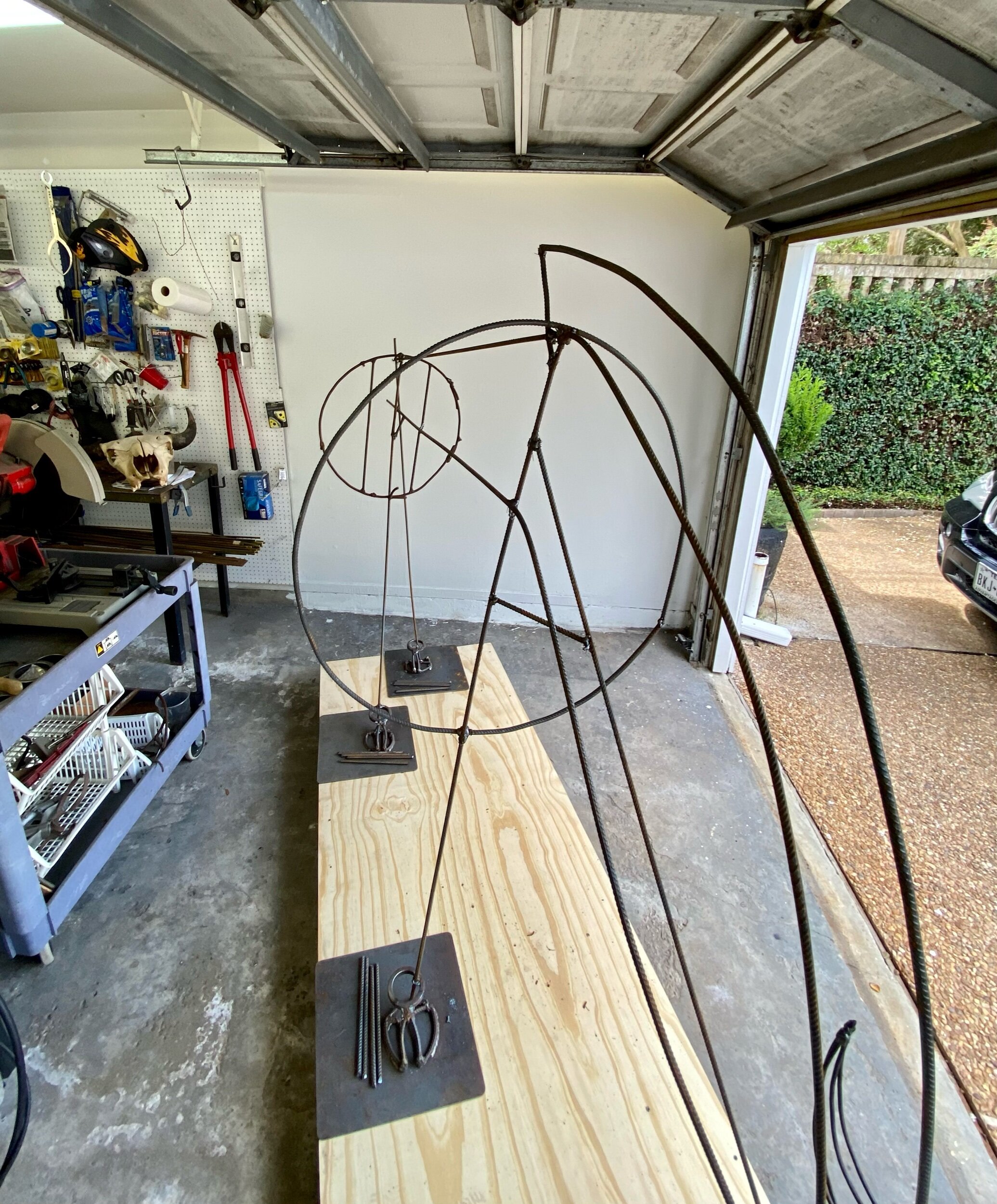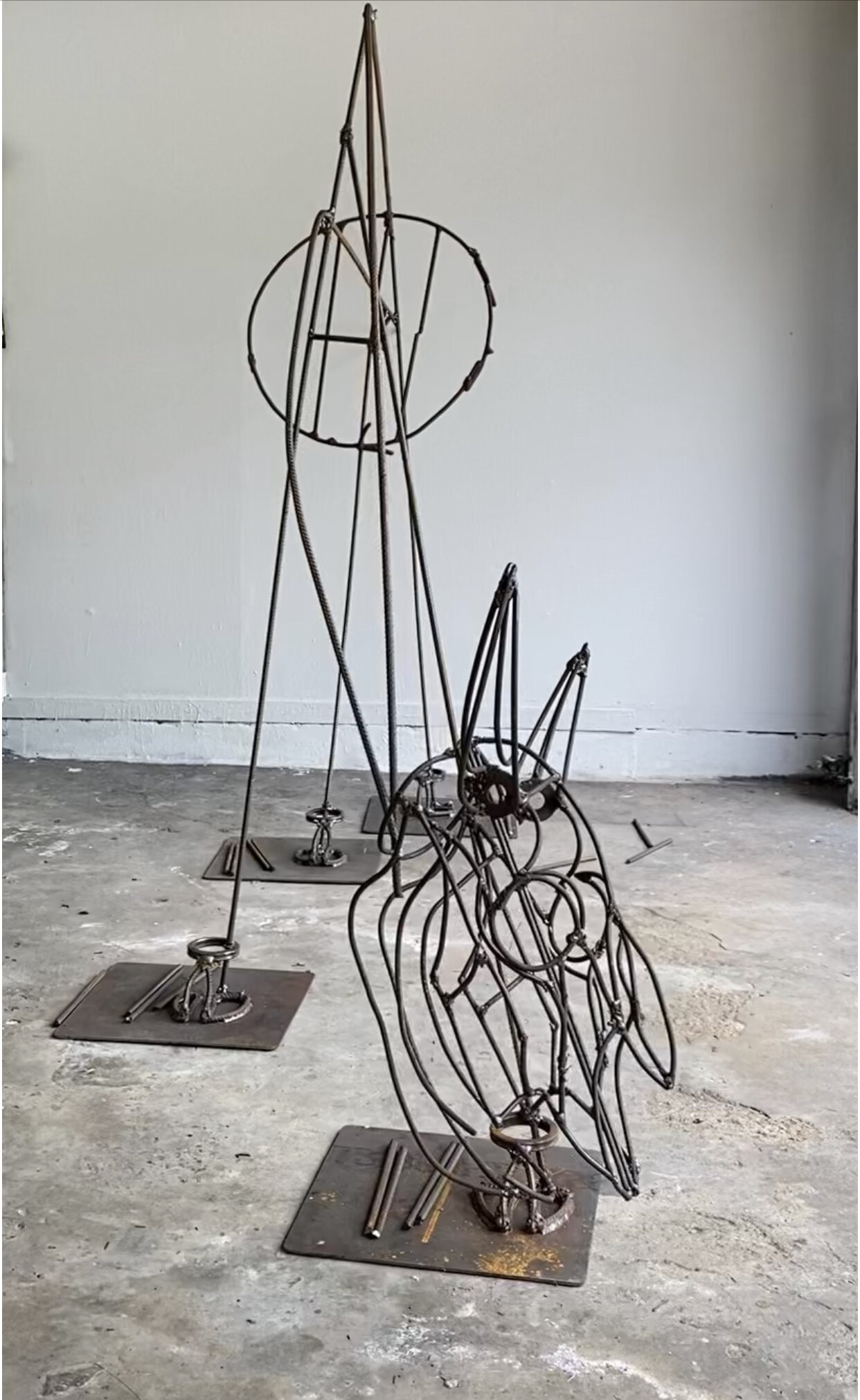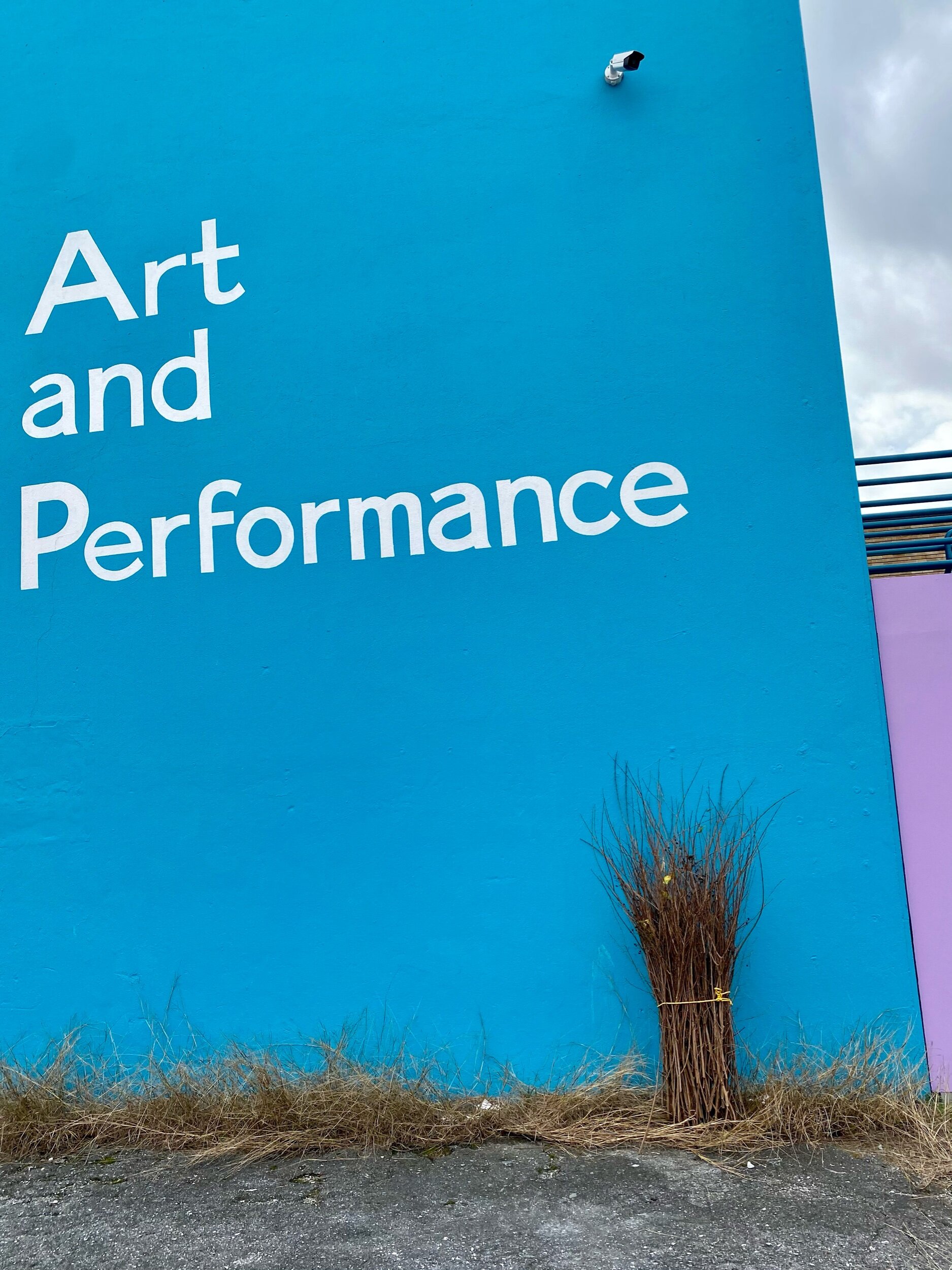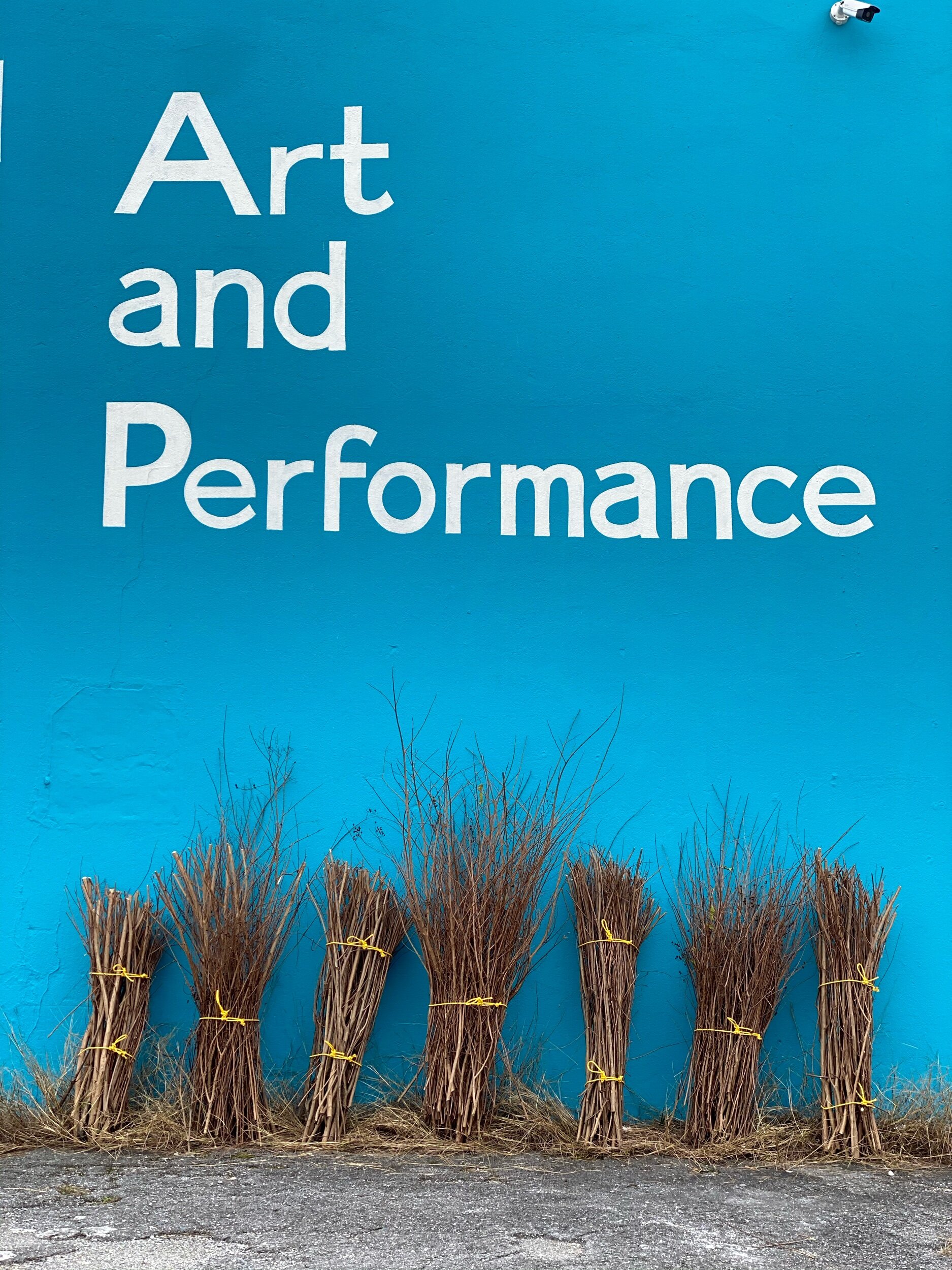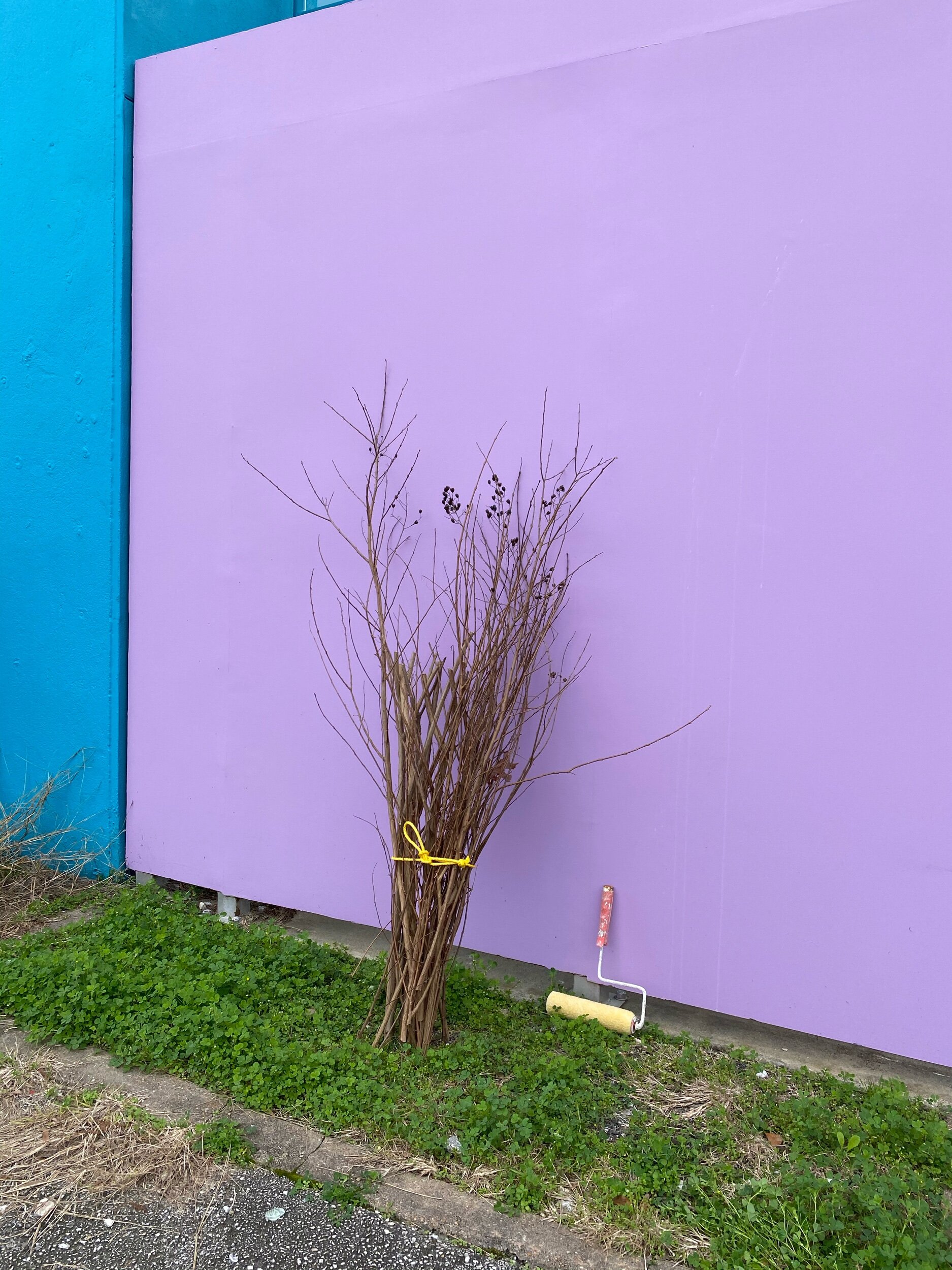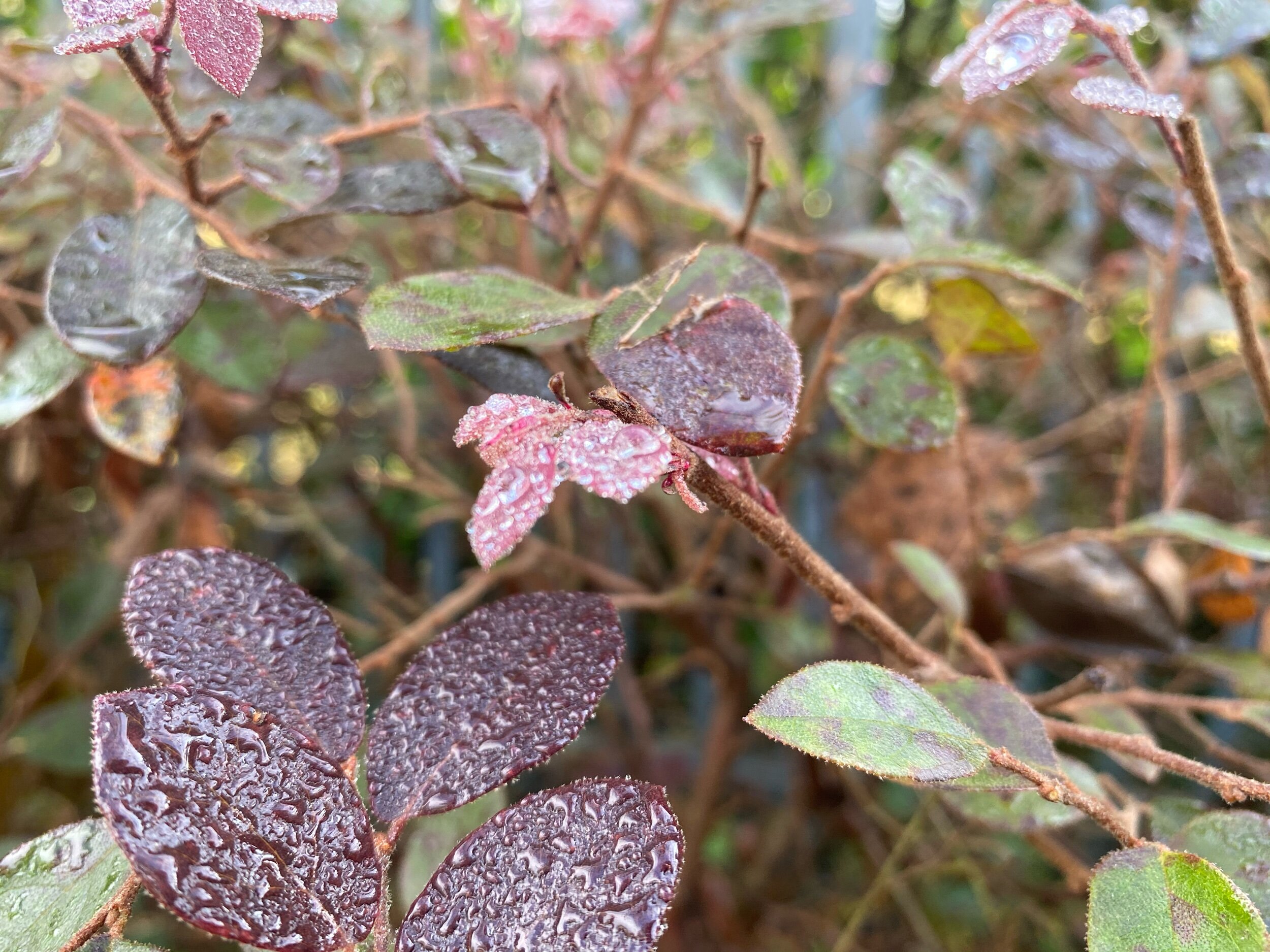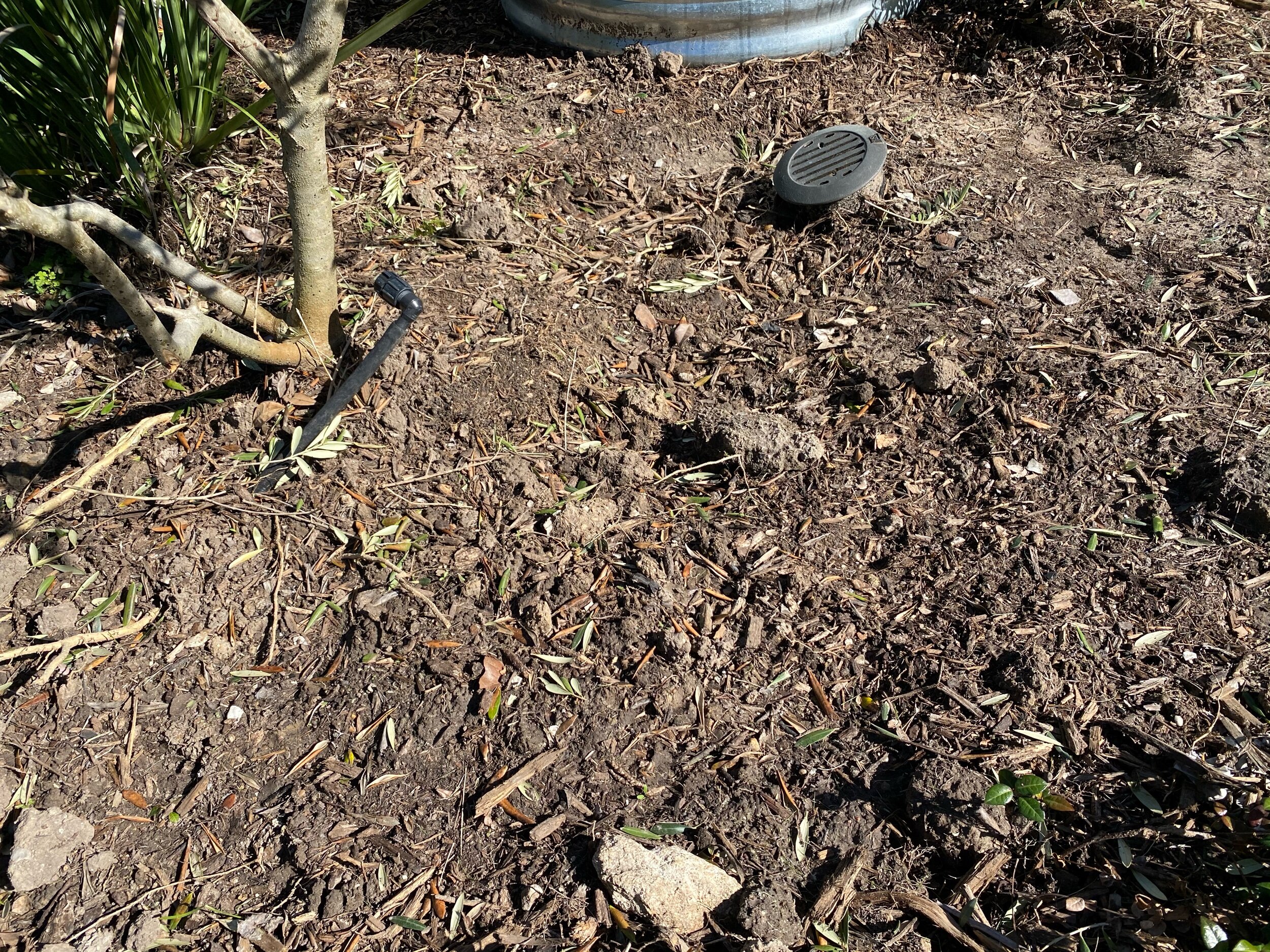Front legs and right shoulder
Endangered Knowledge: The Soul of Humus
20’ more of rebar.
I used 20’ more of rebar today to build the hip bones up on both sides and his right side in the stomach area of his side. I worked from the hip to his shoulder.
My work space is not large enough to get a good side photo.
Endangered Knowledge: The Soul of Humus
Stomach, upper hip bones, and more hump.
He still looks like a hybrid giraffe bison, that is only because his muscles and fur come later.
Endangered Knowledge: The Soul of Humus
Another big day of welding..I added a big 96” circumference chest. Put the entire piece on four dollies and started his hump. Below are a few pics from todays work.
Behind my garage is a telephone pole. I use it to bend my rebar. This is a side view where I am going to bend the piece for the chest.
Halfway to becoming a bison chest.
Then I use my weight to even out the shape.
I hang the chest over the back and decide if it is big enough.
Next I weld the ends together .
Recycling some old dollies from past work and deciding on the best plan. Balance and portability is the goal. The brown paper is the footprint of my bisons. Each leg is supported by a dollie.
Thanks to Curtis for getting me the plywood and helping me mount the beast. This is just for while I work on the sculpture and for transportation. It is not part of the work.
Just goofing around
My garage studio assistant is taking a sun break.
Starting to assemble the hump.
And that's a wrap.
Endangered Knowledge: The Soul of Humus
July 5th.
Attaching the head—
I welded just one connection from the neck to the head. As I assemble other parts of his body I will continue to evaluate the position of the head. I want him to be his reaching to the side searching for the next blades of grass within the reach of his massive head and tongue. With only one weld I can easily cut it off if I decide it is not in the right place or at the right angle. I do enjoy having a bobblehead bison in my garage for a while.
Building the girt—
I happened to have a circular scrap piece of rebar almost the right size. I created it years ago to be a round seat for a faux bois chair that was started and not finished. I turned it into the basis for the bison’s rear hip girth/stomach.
It is a little small, the small size gives me the flexibility to add to it exactly where I want it to protrude. As I get more elements worked out I will make it larger by adding the back hip bones that protrude. t is a lot easier to add pieces as I build him than to cut out pieces.
1 small tack world neck to head. Just to see where I want it.
Spontaneity and art - a good thing, we will see
I started my day at 6:30 am, pasting images of work into a word document for a curator/art consultant. A necessary task that I was thrilled to do- however, mind-numbing, to say the least. By 12:30 crossed eyed I took the dogs on a walk. When I came across this. My mind numbing was instantly healed with inspirational thoughts.
Seven immaculately bundled trimmings from a neighbors Crape, Myrtle. Crape murdered or not I- the trees were in the backyard, could not see them.
My trimmings from a site-specific installation @Lawndale Center for the Arts. Symbiosis
The image above is from last week at Lawndale (a post in am tardy with) My trimmings are wild and unruly. I am using them on social media to make a point - to change how we landscape- to landscape with habitat for wildlife in mind.
My neighbor's bundles of limbs are in sharp contrast to mine. They are an example of how controlling urban green spaces have become, the tidiness that is expected In our yards.
I am so tempted——— Such a great opportunity to turn these found object organic materials, perfectly assembled tied up with yellow cords into gorilla art. The colors will look amazing at Lawndale. It is not part of my work on Symbiosis to install anything I want. 🤔 The entire dog walk I was haunted by the bundles and their yellow cords. I am not comfortable installing gorilla art but I am excited with the idea and I know Lawndale won’t have me arrested like other institutions might if I randomly installed objects in their sculpture garden, right?
I have always challenged myself to take on the art that scares me the most- to embrace the butterflies as my son tells me. You don’t know until you try. - jump
I went to the door, I was hoping no one was home, Abby was a new neighbor and I introduced myself. - she moved in during Covid. We had a nice chat and she welcomed me to take her piles.
It took two trips
😁 when I bring new materials to Lawndale, I like to photograph them on this turquoise wall- documenting my materials. And I have to say! I love the colors - the Textures.
I declare this installation number 1. Untitled.
This technically is not Lawndale property, the wall is theirs, but the lot is unfortunately not owned by the institution. The lot is vacant. I get all the bundles out so I can pick up load number 2.
Installation number 2
Installation number 3
The yellow ties make my heart sing, that rich brown against the turquoise, and the golden grass softening the base, I am in heaven. I see ballerinas chins up, lined up to take their bows center stage. I had one left.
A painter from last week left their yellow roller- waste not want not. The clippings Are rich on the violet too.
Sometimes I feel guilty that I love my work so much.
There are bees that have not been seen since the 60’s that are not listed as endangered.
After reading the document that listed Bombus Affinis as an endangered species I formed my own opinion by and it does not reflect well on the chemical industry.
Bombus Affinis - the rusty patch bumble bee
Lawndale’s Symbiosis - constant research
Symbiosis is a long term art installation. A piece of dirt in the middle of a large US city, an ecosystem that serves the local art community. Through pairing my intuitive sculptural practice, and natural history research I am sculpting the garden into an ecosystem that balances the needs of the Homo sapien art community and the urban natural world. I spend much of my time filtering through biologist research, inspirational documentaries and interviews of individuals that are leading the way. New Year’s Day I listened to a remarkable podcast an interview of Nora Bateson who is an award-winning filmmaker, writer and educator, The podcast was taped before the pandemic. She knows what she is talking about. Here are two quotes from the podcast that gave me pause and reminded me how grateful I am for my opportunity to make a difference through Symbiosis at Lawndale
“ In my little fantasy there is a great big pause button, and we can say hold everything, let’s regroup, let's turn this titanic around”
“One way or another the systems that we are within are going to change.”
A very enlightening podcast regarding how change and regeneration happens. It is haunting to consider this came out before the Covid 19 quarantine of 2020. Everything Nora talks about addresses the things I am thinking about. She is most definitely an influencer. I will continue to follow and monitor her work.
You can find the interview at The Regenarration podcast on Soundcloud Solve Everything at once.
Checking on the garden I found a moth that was still alive laying in the Pond. I rescued him and laid him out to dry.
Lawndale symbiosis - milkweed and monarchs
I have read that a few migratory monarchs spend the winter in the Houston area and join a small resident population of monarchs. I have also read that it is essential to choose native milkweed as opposed to tropical. Tropical milkweed—doesn’t die back in the winter as native milkweed does. When a place to lay their eggs year-round is available, many monarchs don’t bother making the trip to Mexico.. I saw this caterpillar on my morning walk. It was seriously munching on the milkweed. Milkweed is the only plant that provides the nourishment that will transform the caterpillar into a monarch butterfly. It is important to plant only none-hybrid native milkweed. Texas milkweed will be included in my 2021 Lawndale Art Center Sculpture garden piece Symbiosis. In Symbiosis, I am stretching my practice and creating a living piece of site-specific art activism that will reimagine a 53.5’ X 48’ traditional urban landscape/sculpture garden and answer the question: how do we holistically restore an ecological balance in Houston? Symbols is a collaboration with Lawndale Art Center’s community, neighbors, urban wildlife, and the coastal prairies' carbon cycle. For more details see this link.
#carboncycle #cindeeklementart #texasart #houstonart #contemporaryart #modernart #caterpillar #monarch #milkweed #nativeplants #migration #energy #movement
#lawndaleartcenter #symbiosis #artactivism
The day after the caterpillar sighting.
The beauty of a leaf runs deep.
How beautiful droplets of dew or rainwater puddle on the waxy leaf surfaces? They provide the watering holes for nature’s tiniest creatures.🐞🐛🕸️🦎🐌🐸🐜🦋🐝
What do you see when you see a leaf? ☘️🌿🌱🍀
I see a unique natural system. Leaves multi-functioning as micro reservoirs, coats of armor protecting the soil, and micro floodgates slowing rainwater. 💦🌊💧
On the Coastal prairie, leaves function to protect the soil from being compacted by the pelting raindrops. If the heavy raindrops fall is not broken by layers of leaves and organic matter, the tiny cavities in living soil collapse, and rainwater moves horizontally across our landscape instead of into the tiny reservoirs in the soil. We need these small cavities to allow water to penetrate deep into the soil. Leaves also slow rain droplets giving the soil time to transport the rain to its deepest roots. Once the rain is in the ground cooling our planet leaves protect the soil from the heat of the day. This multilayered ground cover gives rain more time to trickle into the aquifer. Purifying our water and cooling our planet. How amazing are leaves? As an artist my how we see urban landscapes
My work records endangered knowledge to the collective memory and reimagines urban landscapes to holistically balance the needs of humanity and wildlife.
In Symbiosis I am stretching my practice and creating a living piece of site-specific art activism that will reimagine a 53.5’ X 48’ traditional urban landscape/sculpture garden and answer the question: how do we holistically restore an ecological balance in Houston? Symbiosis is a collaboration with Lawndale Art Center’s community, neighbors, urban wildlife, and the coastal prairies carbon cycle. #symbiosis #lawndaleartcenter #urbanlandscapes #artadia #coastalprairie #water #leaves #conservation art #bioart #nature #contemporaryart #modernart #artactivism #cindeeklementart #texasart #houstonart
Symbiosis- fluffy bluestem
Through art, I am finding new ways to see Houston’s urban landscapes. The bushy bluestem is a coastal prairie native and a volunteer at Lawndale art center, the location of my 2021 site-specific sculpture installation.
For creating movement and living soil, bushy bluestem is a fabulous material to consider. At this point, I do not know if it will make the cut of materials for the sculpture; however, it does have some attractive characteristics as a material for living soil, and aesthetically I think it is beautiful. The spikelets of silky feathers curl out of a sphere of fine hairs. It is tall and graceful, peering five feet off the ground. In my mind, I can see a cluster of them suited in costumes of golden cotton candy swaying across the stage of coastal prairie under the spotlight of our earth's closest star. Their rhythm succumbs to the breeze that sweeps off the coast. They create the perfect; kitchen of seeds for birds and small mammals, cozy nesting materials for birds, winter food for prairie chickens, field sparrows, and juncos. I can hear a symphony of songbirds serenading the morning as butterflies flit, and flingle and native bees start their day. With close inspection and a little luck, you may even discover a Skipper or Satyr larvae starting a new life amongst their stems. #symbiosis #cindeeklementart #livingsoil #sitespecificart #texasart #bushybluestem #houstonart #texassculpture #contemporaryart #nativebees #bees #wildlife #livingsoil
Changing how we see urban landscapes in Houston.
Grasslands vs. trees
When it comes to the environment in the 21st century grasslands beat trees when it comes to carbon sequestration. Our planet is a living breathing organism, impacted by our actions, always changing. I believe It is important that we constantly observe and evaluate how it changes as humans developed and expand across it.
Trees are a thing of beauty but they store carbon above ground in their trunks and limbs.when they catch on fire the trunks and limbs release their carbon into the atmosphere. Grasslands storing carbon underground release little carbon when they catch on fire. In addition the grasslands are a giant sponge soaking up water that prevents dryness and fires.
With the forest fires we have suffered world wide it is time to plant more grasslands and turn these areas suffer ending from droughts into giant sponges for soaking up water and carbon. When the ground is moist then we can can start adding back trees.
Drying coastal prairie native grass in my studio.
ROOT TO WATER
”Root To Water” 24” X 12” X 12” irrigation wheel and root found objects.
“How fleeting are the wishes and efforts of man! how short his time! and consequently how poor will his products be, compared with those accumulated by Nature during whole geological periods.”
—Charles Darwin, Origin of the Species
Root to Water offers hope. The root, placed with the root system up, takes on anthropomorphic characteristics, as the wide spread irrigation wheel’s legs are firmly grounded, the humanized root’s bent over posture and downward pointing arm are alive with discovery, the root’s hair like tendrils are actively rewiring its human anthropomorphic brain. This rewiring is happening across the globe, in the most desolate of landscapes citizen conservationists are studying natural law and finding solutions to their man-made problems.
In Root to Water, the irrigation wheel symbolizes mechanistic systems. The root in its natural state represents ecological systems. With this duo, I propose that modern civilization has reached an advanced stage of industrialization. In order to progress to the next stage of civilization we must heed Darwin’s observation, and answer the question how do we pair mechanical innovation with the systems that have functioned through “whole geological periods.” I placed the root above the wheel supporting Darwin’s view of natural systems superiority to human innovation.
Repurposing two tools from agronomy, Root to Water shifts how we see mechanical systems versus naturally occurring systems. In this sculpture, a modern innovation—a rusting, decorative, human-made irrigation wheel—serves as a pedestal for an organic found object that often goes unseen: a root system. With this pairing, I exhibit man’s historical struggle to transition to an agricultural-based society utilizing human-made innovations that extract natural resources instead of harnessing existing ecological systems that regenerate resources.
Communities across the planet are experiencing extreme cases of natural disasters. Houston has experienced three 500-year floods in three years. The U.S. Army Corps of Engineers completed the Buffalo Bayou and Tributaries Resiliency Study, proposing options for controlling flood waters costing up to $12 billion. The report does not include conveyance options that are local nature-based cost effective solutions.
A growing number of conservationists are using natural systems, specifically roots, as a tool for water transportation, carbon sequestration and as a means to cool the planet. Meanwhile, industrial agricultural produces products that are depleting the organic matter, releasing carbon from the soil, and contributing to global warming. As evidence consider, “Each 1 percent increase in soil organic matter helps soil hold 20,000 gallons more water per acre.” In contrast, industrial methods strip the soil (releasing carbon), use petroleum-based inputs to enrich the soil and kill pests. Root to Water elevates roots as a natural system that transports water, minerals and carbon; stabilizes soil; and is instrumental in cooling Earth’s surface—a live-able solution for global warming.
My research-based art looks at the natural history of living soil and how it can be used to restore natural resources that is not commonly understood. I champion natural solutions to environmental issues with a focus on urban landscapes. Root to Water is part of my Endangered Knowledge work, a body of work in progress.
“Though the problems of the world are increasingly complex, the solutions remain embarrassingly simple.”
—Bill Mollison
Further Reading
-Judith D. Schwartz, The Reindeer Chronicles, Water in Plain Site, and Cows Will Save the Planet
-Kiss the Ground, Directed by Joshua and Rebecca Tickell, with WoodyHarrelson
-Organic Matter Can Improve Your Soil's Water Holding Capacity
-The Loess Plateau was the, most highly erodible soil on earth”
Armadillos and termites
Termites - to quote @gjklement,” termites are the ultimate grazers” last week, after we harvested our turkeys @roamranch, we went on a hike along the pastures to Indian Cave Creek. Along the way, we saw an abundance of armadillos eating termites. This trip was my 6th trip to the ranch and the first time to see any armadillos on the property, much less numerous armadillos or notice any termites. It is a sign the soil is regenerating - it is a good thing. Armadillos play an essential role in the Texas landscape both in agricultural settings and in urban population centers. They eat Termites keeping them in check. The termites are essential in building functioning ecosystems. As an art activist, I want to change the way we see nature. #regenerativeagriculture #regenerativeart #cindeeklementart #bioart #cobservationart #artactivist #texasartist #houstonartist #womansculptor #art #sculpture
Symbiosis building soil life.
How do you build soil health without having the luxury of animal impact. It is one thing to build soil health on a bison farm. The microbes in the the the bison, turkey, pig and chicken dung builds the life in the soil. In the sculpture garden at Lawndale I am going to use LEAF MOLD COMPOST. This product is produced primarily from recycled leaves, with a little grass and horse manure mixed in, a touch of fruits and vegetables. After a long slow compost it will be rich in beneficial microbes. It will help save water and promote healthy soil. I was going to wait until early spring before we replanted the garden. However, Sunday Lawndale is having it's Sunday brunch fund raiser. And this is in the day if Covid 19 so the event is outside. I noticed that the heavy rains of late have compacted several areas in the beds and washed away some soil. It will be an opportunity to to talk about living soil,
I spent time researching different types of compost and mulch. Natures Way Resources compost native plants, is locally owned and located in the Houston area. The owner is a soil scientist. I had a long conversation with him today and he really knows living soil. I can't wait to see life return to the garden.
Here you can see how the soil is wearing away without having plants/roots hold it down. You can also see how the rain hitting it had compacted the ground. When the soil becomes compacted it stops absorbing water. .
The goods
The tools
Happy Soil Day.
Happy National Soil Day. Notice the length of the root system of this turf grass-just a few inches. 👎
🤔
The image I posted is not soil to be celebrated.It is what I call mindless conformity 🤨AND - now for the good news- 🌱☘️🍀☘️🌿
It is an opportunity to help save our planet and that we should celebrate.
Let me explain- this is the typical ground cover that covers 99.99% of the homes in the United States. It is a mono-crop of turfgrass. Monocrops are not healthy for soil. Mother Nature needs diversity to be healthy. To go against nature, homeowners have to apply chemical inputs to keep their monocrop turf grass looking perfect. These fertilizers, fungicides, herbicides, and pesticides kill all the living matter. They also kill our insects and valuable Keystone species.
In contrast, healthy soil, especially on the coastal prairie, is a sponge for soaking up rainwater and keeping our planet cool. Houston was a coastal prairie covered in native grasses that had massive roots systems. Some extended 18’. The coastal prairie has the capability to absorb massive amounts of moisture/water. They also act as a filter to clean the water and retain water. Water held in healthy soil is how the planet cools itself. Healthy soil also sequesters carbon out of the air and puts it back into the soil. The coastal Prairie plays a large role in the global environment. Houstonians have paved, asphalted, and covered in turf grass 600 square miles that makeup Houston. Reimaging urban landscapes is an opportunity to save our planet. Turfgrass covers more acreage in the US than farmed land. 🤠 this is an easy way to comply with mother nature. I am using ny art to find ways to reimagined urban landscapes to work with mother nature Healthy soil= healthy people. Happy soil day. #cindeeklementart #artactivism #bioart #soilart #art #conservationart #soil #regenerativeart.
Lawndale Art Center — Symbiosis environmental art activism project announced
Lawndale Art Center a staple on my radar as a possible venue for an environmental art exhibition. The sculpture garden, primed to be relandscaped in a manner that could communicate any number of environmental issues in my head.
The Lawndale Art Center Sculpture garden before the 2019 re-landscape.
I have had a few casual discussions with Stephanie about these ideas in the past, however other opportunities came my way, and frankly, I dropped the ball.
During the first COVID 19 quarantine, Lawndale Art Center reached out to me regarding their sculpture garden. They were interested to know if I would assist them with some weeding in their newly landscaped sculpture garden, I often volunteer there. When I heard the words, “newly landscaped sculpture garden,” my heart fell to the ground. I had blown it, I missed the best art venue opportunity to create a piece that looks at urban landscape as a found object. I was crushed, disappointed and angry at myself. I decided to focus on my Endangered Knowledge: The Soul of Humus, a piece I am creating for Sculpture Month Houston. In turning Lawndale down I sent them a copy of the proposal I made to SMH. A few days later I remember thinking to myself, “well you blew that opportunity, you will never get a show at Lawndale now.” A few weeks after that— they called me back and asked me to meet them at the sculpture garden. Masked I met with Stephanie and Emily and they asked me to do a site-specific environmental piece in the newly relandscaped garden. It was the last thing I expected—A dream come true was not in my mind of possible COVID19 realities. We also discussed their need for some happiness in the garden. The garden does not have any beneficials planted. Sympathetic to their need for some visual happiness I offered to plant a few flowers.
By this time it is unbearable—Houston—July—Hot.
What can you plant in July and have it not fry, if anything? I am not an experienced gardener I am an artist/activist and a citizen environmentalist—but my friend and past President of the Harris County Master Gardeners, artist, and curator is a very knowledgable gardener. A super busy Renassaince man, Will Isbell kindly offered to meet me on a Friday evening at the garden to see if there was anything I could plant that would not die in this July heat. There was not, but we did have a great talk.
We both saw the existing garden in the same way a missed opportunity for an environmental artist. And then it hit me. I suggested that I propose to Lawndale that the two of us do a project that takes the existing new traditional landscaped garden and use it as a found object to create a piece to activate change in Houston’s landscape. Will did not hesitate.
The question was how do I get them on board. They have already spent good money and the garden by any standards is beautifully done. One thing everyone knows about Lawndale, it is an art space for the voices of artists breaking boundaries and unearthing contemporary knowledge, nothing is too daring for Lawndale. They are the space in Houston to open minds. They were encouraging and interested in this new idea and wanted me to continue working on a concept for a solo environmental piece as well the piece with Will.
I am still num with these two opportunities and excited with the potential to instill hope and heal the environment.
Lawndale announced the project Will and I are doing together last week. Below is the proposal for the work. I wrote it in early July, as I read the opening paragraph today, with California on fire, and Houston flooding again I am taken back by how much the world has changed since I wrote it.— and not in a good way.
Lawndale Sculpture Garden Proposal
Cindee Travis Klement and William Isbell
What is to be gained in the year 2020, the year of perfect vision? In our largest cities, a tiny virus is killing our most vulnerable, crippling our strongest economies, forcing our families into food lines, and providing kindling for social reform protests. In the natural world tucked within our largest cities, this same tiny virus has improved the air that we breathe, returned fireflies to our summer nights, and allowed wildlife to inhabit our neighborhoods. The connection between the land, plants, mankind, and wildlife in urban environments has never been more evident.
What is to be gained in the COVID 19 moment of enlightenment: our eyes have opened to the state of our living systems, and we have discovered that unimaginable change is possible. We have seen that we cannot wait for the tests to tell us if we are sick. Without design, we have found an unprecedented moment, we have gained an opportunity to change.
SYMBIOSIS
As visual artists and art activists, we will connect soil health and the health of our city. We will create a living piece of site-specific art activism that will reimagine the urban landscape and answer the question — how do we holistically restore an ecological balance that can coexist in Houston with nature/ wildlife through sculpture and community involvement. We see the Mary E. Bawden Sculpture Garden's terrain with its manicured, status quo landscape as our found object. With ordinary tools, organic matter, with the help of the community, we will sculpt it into the armor that historically protected Houston’s geological epidermis and gave life to its keystone species — the Coastal Prairie ecosystem. The title of this found object sculpture is Symbiosis. Over time Symbiosis we will morph into not only a landscape but also a soundscape that changes kinetically with the seasons.
Lawndale’s Mary E. Bawden Sculpture Garden’s Symbiosis will be a catalyst for change. In addition, it will be functional as a contemporary art exhibition space, a piece of functional activist art as well as a healthy ecosystem/habitat: a sculpture garden that heals and honors the history of the land.
Physical Description of Piece
Once the parameters of the project more are specifically defined we will insert the specific plants, their ecological roll in the
design and define the work.
Environmental Impact
Soil scientists around the globe agree that solutions to global warming, soil erosion, water runoff, drought/flooding, loss of wildlife habitats, and species extinction are rooted in the treatment of our soil — the skin that covers our planet, which includes our residential and small business landscapes.
Restoring the native prairie vegetation increases soil absorption of water and slows floodwaters on land, decreasing water runoff. For every 1% increase per acre of biological organic material, the soil can hold an additional 20,000 gallons of water. Given Houston’s extreme building practices and concrete hardscaping, reimagining the landscapes within Houston's 600 square miles of real estate can significantly impact the region's flooding. In addition, the roots of vegetation in a coastal prairie can extend from eight to fourteen feet deep; these roots sequester and store carbon like an upside-down rainforest, cleaning our air.
Value of Location
Change can happen at lightning speed when innovation is coupled with imitation.
The current state of Lawndale's sculpture garden provides the perfect opportunity to break the mindless conformity that dominates Houston's urban gardens/yards. The sculpture garden has the feel of a perfectly manicured, traditional front yard, making its size and plant selections relatable to the general public.
With the Houston Arboretum transformations, Katy Prairie Conservancy, Buffalo Bayou, and the new Memorial Park renovation, Houstonians have awakened to the importance of native Coastal Prairie landscaping; however, those sites are enormous tracts of land. It isn't easy to visualize those landscapes outside the parks. This permanent and living metamorphosis of Lawndale’s Symbiosis will provide the 2020 vision of transformation by imitation for yards throughout Houston. It will shift mindsets by prompting Houstonians to question Houston’s urban landscaping and imagine a holistic Houston that protects the environment by balancing human, natural and economic systems.
Value for Lawndale Art Center
An art institution that looks at its community holistically to include not just a monoculture of humans but also beneficial plants, animals, and micro-organisms will be groundbreaking. Symbiosis will cultivate a medley of life that historically has defined the place, has impacted its economy and attracted its people. Lawndale’s Symbiosis will leverage this endangered knowledge with a living site-specific art installation that provides the artistic vision that changes hearts and minds. It will connect the history of the land to contemporary art. Using additive and subtractive sculpting techniques and nature the Symbiosis of the Mary E. Bawden sculpture garden will become a living love letter from our past to our future.
Ecological impact of Houston
With 2.3 million people living on a footprint of 600 square miles, close to the Gulf of Mexico, located along the migratory bird pathway, Houston is an urban wildlife sanctuary.
Changing Houston's ecology will profoundly impact our oceans, human life, wildlife, and microbial environmental health. Let’s not miss this unprecedented opportunity and heal the skin of the planet and our people.
Installation Process
The beauty of this piece is to have it be a catalyst for inspiring homeowners and businesses to imitate the change and heal their landscapes too. We will Involve the community to take on an active role in the transformation. Installation of the piece will engage and educate the community in ways to be defined after specifics of the piece are worked out.
Lawndale after one of our early Symbiosis meetings.
Beautiful new fence and Jasmine and crepe Myrtles.
Olive trees, African Iris, Dwarf Yupon Holly, Gardenias, Asian Jasmine, Crepe Myrtles -6 very popular landscape elements across Houston.
Will’s and my found object — Lawndale Art Center, Mary E. Bawden Sculpture Garden
Rumblings - Bombus Morrisoni - repeat
Bombus Morrisoni II
Bombus Morrisoni II Ghost
I was not happy with the first Bombus Morrisoni so I made more. The first is swimming in violet blooms
Bombus Morrisoni III
Bombus Morrisoni III ghost
Why soil?
“The soil is the creative material of most of the needs of life. Creation starts with a handful of dust.” - Dr. W. A. Albrecht ph. D.
That is a powerful thought. How important is soil to our health? For me it is clear.
And it is not dirt, it is not clay, it is humus living soil.
This quote is deeply tied to all of my current work, in The Endangered Knowledge piece that I am in the early stages of welding soil is the material that will become the protective layer of the keystone species, in Subterraneous Secrets soils energy is stabilized and captured through root systems, in Mute Testimony, it records its history, in Gust the life it provides is Endangered. In the photography of life in my cement pond, it establishes natural rhythms and compliments the other living systems. The pond is a complete ecosystem; it is free of pesticides and herbicides. In this type of ecosystem, even the blooms in their last phase of life are beautiful as the tiny microorganisms convert them back into minerals that build soil health. #inmycementpond In this image, you can not see the humus, but you can see the magic in the life it brings when we allow it to thrive in a natural state.
Endangered knowledge: The Soul of Humus #17 Cowbirds
I just read an intesting article; how Cowbirds are hedging their bets when choosing surrogate birds to hatch and raise their young. Another instance that supports the theory that diversity is the ticket when it comes to the survival of a species.
Coincidently I picked up the bronze Cowbirds yesterday. They are ready for me to recreate the texture where they were damaged during the spruing process. Once that is complete I will deal with their patina. I should wait and decide on their finish once the abstract bison is further developed. That said I am excited to see how the materials will look in a polished finish. Below are closeups of each bird - just for the record.
The finishes are very powdery looking and flat because they were just sandblasted. When I decide on the patiba the textures will really show up.
I took a risk when I decided on the manner in which I would create the birds. The Cowbirds are constructed in a primitive manner. And they look extra primitive laying on the faux bois chair. Context impacts the way we see. I feel hopeful the organic and rough construction will work on the abstract beast they will be attached to. Roughly constructed they support the story, polished perfectly detailed birds would not relay their connection to the geography and mammals. I realize I have not taken the safe root and hope I didn’t need to hedge my by as the Cowbirds did theirs.
The big bird side 1
Opposite side.
On this image you can see a smooth surface from where the sprue was cur off. One spots the I will retexture.
From the top
Bird 2
Bird 3
Derail shot of bird 3 - you can see the seeds and grass stems.
Bird 4
As I recall this one gas some bluebonbet seeds in it's back feathers.
Bird 5
Texture gives me good goosebumps.




